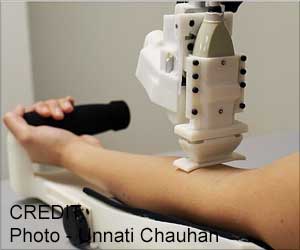Furthermore, accidental needlestick injuries to healthcare workers occur frequently and can be serious. Healthcare-worker infections from needlesticks may occur at a rate of about 3 in 1,000 needlesticks and the most worrisome are exposures to hepatitis and HIV.
To improve blood collection techniques, medical professionals have been investigating the use of ultrasound imaging and robotic devices. Most recently, researchers conducted the first human clinical trial to evaluate a robotic device that collects blood samples for laboratory testing.
Robots Will Draw Blood Samples In The Future
The ultrasound image-guided robot finds the vein, punctures it with a needle, and then draws blood. Though the trial showed promising results, improvements to the device and more studies are needed before it could be used in clinical practice.
Advertisement
The robots could make blood draws safer for both patients and healthcare providers. The technology could potentially help make blood draws much quicker and easier, especially in people whose veins are difficult to access. It includes veins that can’t be seen or felt easily and those roll out of position easily.
Though the new clinical trial focused on routine blood draws, robots could be adapted for other uses, such as administering fluids or medications through a vein (IV therapy), dialysis, or arterial line placement.
How Successful Were Robots In Taking Blood Samples?
The first clinical trial of the robot involved 31 human participants, including six with veins that were considered difficult to access. The robot successfully drew blood into collection tubes with one or two needle insertion attempts, a rate of 97% in patients whose veins were considered normally accessible and 87% in patients overall[3].
The device’s overall successful blood collection rate is comparable to that of manual blood draws, which is about 90%. The device was unable to collect blood from three participants with difficult veins.
Researchers say failures were likely due to veins rolling out of position as the needle attempted to puncture them. No subjects with normal or difficult veins suffered bruising, punctures to the back walls of blood vessels, or other inadvertent injuries.
Robots Are Not A Replacement For A Trained Clinician
Much more work would be needed before the robot could be used in a clinical setting. Researchers are planning to make improvements to the device and conduct follow-up studies.
Future research will involve a direct comparison of the success rates and the time needed to complete robot-performed blood draws versus manual veni-puncture, with and without ultrasound guidance. Such research would also involve larger groups of patients.
Whether a robot can ever truly replace a highly trained clinician remains to be inconclusive. It’s more likely the device will be an aid rather than a substitute, freeing up healthcare professionals to spend more time treating patients.
But it could also lead to earlier diagnosis and treatment, with the machine performing the analysis straight away rather than patients waiting days for tests to come back from the laboratory.
This would streamline and decentralize the whole blood-testing process so it could be done in an individual doctor’s office, and patients can be treated based on the result.
The prototype device will need to go through rigorous testing and safety checks before it can be submitted to regulatory agencies for approval. And alongside science and engineering expertise, investors who are prepared to back the project for the long haul will be crucial to the device’s success.
References:
1. https://www.worldscientific.com/doi/10.1142/S2339547819500067
2. https://www.researchgate.net/publication/275989947_Complications_of_venepuncture
3. https://www.rutgers.edu/news/new-robot-does-superior-job-sampling-blood
Source: Medindia



